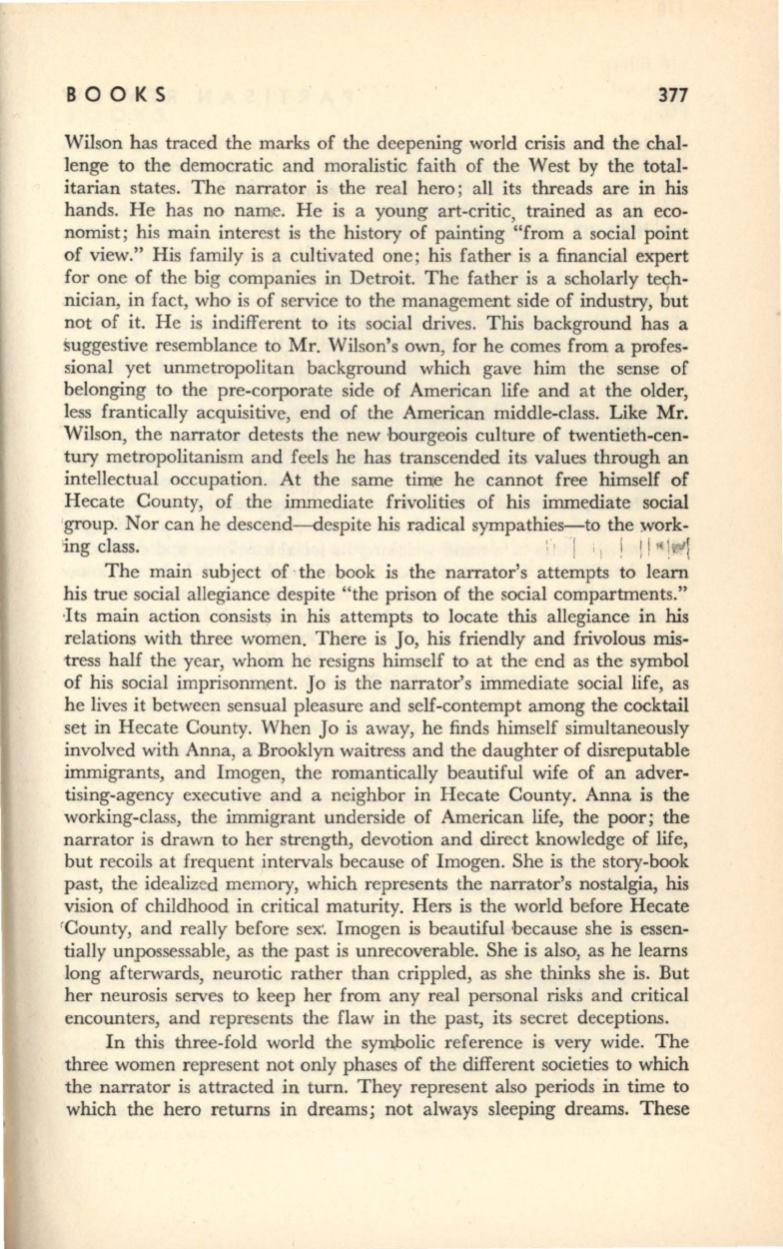
B 0 0 K S
377
Wilson has traced the marks of the deepening world crisis and the chal–
lenge to the democratic and moralistic faith of the West by the total–
itarian states. The narrator is the real hero; all its threads are in his
hands. He has no name. He is a young art-critic, trained as an eco–
nomist; his main interest is the history of painting "from a social point
of view." His family is a cultivated one; his father is a financial expert
for one of the big companies in Detroit. The father is a scholarly tech–
nician, in fact, who is of service to the management side of industry, but
not of it. He is indifferent to its social drives. This background has a
suggestive resemblance to Mr. Wilson's own, for he comes from a profes–
sional yet unmetropolitan background which gave him the sense of
belonging to the pre-corporate side of American life and at the older,
less frantically acquisitive, end of the American middle-class. Like Mr.
Wilson, the narrator detests the new bourgeois culture of twentieth-cen–
tury metropolitanism and feels he has transcended its values through an
intellectual occupation. At the same tim:e he cannot free himself of
Hecate County, of the immediate frivolities of his immediate social
group. Nor can he descend-despite his radical sympathies-to the :work–
ling class.
: '
I ,
1
!
!I ·
!
fll\
The main subject of ·the book is the narrator's attempts to learn
his true social allegiance despite "the prison of the social compartments."
.Jts main action consists in his attempts to locate this allegiance in his
relations with three women. There is Jo, his friendly and frivolous mis–
tress half the year, whom he resigns himself to at the end as the symbol
of his social imprisonment. Jo is the narrator's immediate social life, as
he lives it between sensual pleasure and self-contempt among the cocktail
set in Hecate County. When Jo is away, he finds himself simultaneously
involved with Anna, a Brooklyn waitress and the daughter of disreputable
immigrants, and Imogen, the romantically beautiful wife of an adver–
tising-agency executive and a neighbor in Hecate County. Anna is the
working-class, the immigrant underside of American life, the poor; the
narrator is drawn to her strength, devotion and direct knowledge of life,
but recoils at frequent intervals because of Imogen. She is the story-book
past, the idealized memory, which represents the narrator's nostalgia, his
vision of childhood in critical maturity. Hers is the world before Hecate
rcounty, and really before sex'. Imogen is beautiful because she is essen–
tially unpossessable, as the past is unrecoverable. She is also, as he learns
long afterwards, neurotic rather than crippled, as she thinks she is. But
her neurosis serves to keep her from any real personal risks and critical
encounters, and represents the flaw in the past, its secret deceptions.
In this three-fold world the symbolic reference is very wide. The
three women represent not only phases of the different societies to which
the narrator is attracted in turn. They represent also periods in time to
which the hero returns in dreams; not always sleeping dreams. These


